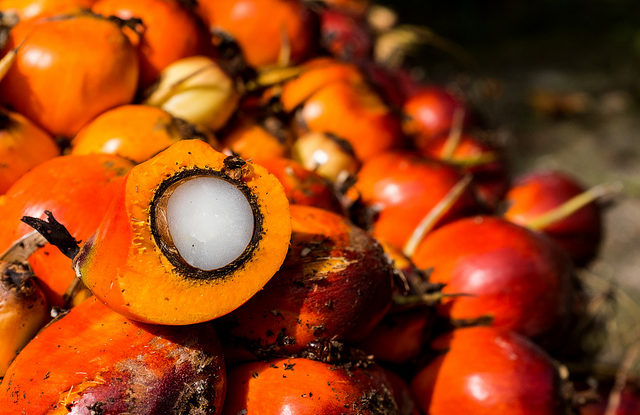(Forests News) — To avert catastrophic climate change, fossil fuel emissions must be cut, but energy demand is tipped to rise by 45 percent from 2013 levels in 2040, according to the International Energy Agency. Under a business-as-usual scenario, this would prompt a 40 percent rise in carbon dioxide emissions, making the need for renewable energies more pressing than ever.
Bioenergy, which is energy produced from biological sources, offers a compelling alternative which is estimated to have the capacity to meet at least 25 percent of global demand. But it is no silver bullet. In the tropics, most biofuel is made from oil palm, which grows quickly and produces high yields. However, clearing forests for oil palm monoculture results in a loss of ecosystem functions, and over time the plantations become less productive. What is worse, the trees can’t grow on swampy peatland soils, so these are often drained for plantations – releasing vast amounts of carbon dioxide into the atmosphere in the process.
Former Center for International Forestry Research (CIFOR) researcher Nils Borchard, who now works at Finland’s Natural Resources Institute (LUKE), became acutely aware of these issues when working with staff at the Indonesian Ministry for Agriculture and Forestry in 2015-16. “They realized that they have huge problems with degraded soils,” he said. “So the cultivation of cash crops – such as oil palm, pineapples, rice and so on – is constrained by the limited potential yields that farmers can gain on these soils.”
The Indonesian government is also aware of increasing energy demands, and is looking for more renewable energy options. CIFOR researchers discussed with them, as well as colleagues from the German Corporation for International Cooperation, how both issues can be combined: rehabilitating or restoring degraded land, and the issue of producing biomass or raw material for bioenergy, Borchard said.
In this context, CIFOR researchers released a review on the topic, which takes steps towards identifying alternative tropical tree species suitable for bioenergy production that can grow on a variety of soils, including those that are waterlogged, like peat. Initially focused solely on the Indonesian context, the researchers expanded their mandate during the research process to encompass other tropical developing countries. The review represents part of an ongoing project “Bioenergy on degraded land,” which seeks to find solutions to three problems – food, energy and environment, said CIFOR senior scientist Himlal Baral.
While there was previously plenty of information on species that can be cultivated on sandy, clay or loam soils, very little data was available for those that would grow well on degraded peatlands. It is a huge gap, especially for Indonesia, which is the biggest global producer of palm oil for bioenergy, and which has drained a lot of peatland in the process.
“The only mitigation option to stop the loss of carbon from these soils is to re-wet the peatlands,” Borchard said. “But on rewetted peatland, the palm oil trees cannot survive.”
Field research and demonstration trials are needed to verify the data compiled in the review, and define exactly which species will thrive in these re-wetted peatlands, and what their likely energy output will be. There are also questions around the practicalities of harvesting in swampy terrain: “You can’t use too big a tractor: you need something in between a tractor and a boat,” Borchard said. “So there’s a lot of engineering research required here, too.”
Now, CIFOR scientists are testing a number of species identified in the review on various types of degraded lands, such as degraded and burned peatland, wetlands and ex-mining land, Borchard said. They aim to keep improving the databases on the topic, and ultimately to produce an interactive tool to support land owners, community groups, investors and policymakers to choose appropriate species for restoration efforts on degraded land.
Mixed plantations, which combine forestry and agriculture, present some exciting options, Borchard said. “It’s a really nice solution,” he says, “because you can cultivate trees for bioenergy purposes, and then grow pineapple or banana or whatever fruit for subsistence or local markets – or even cash crops – so it’s a good way to combine all of these issues.”
While the publication focuses on the potential bioenergy of particular tree species, soil degradation and landscape restoration are much broader issues, which are crucial to meeting the Sustainable Development Goals (SDGs), Borchard said. “We need to rehabilitate these soils, so that they can produce benefits in terms of yields and ecosystem services, and better serve the livelihoods of local people.”
This research was supported by the National Institute of Forest Science (NIFOS) and the Republic of Korea.
We want you to share Forests News content, which is licensed under Creative Commons Attribution-NonCommercial-ShareAlike 4.0 International (CC BY-NC-SA 4.0). This means you are free to redistribute our material for non-commercial purposes. All we ask is that you give Forests News appropriate credit and link to the original Forests News content, indicate if changes were made, and distribute your contributions under the same Creative Commons license. You must notify Forests News if you repost, reprint or reuse our materials by contacting forestsnews@cifor-icraf.org.
Further reading
International Symposium on Forest Landscape Restoration
Replanting the oil palm to save forests
Biofuel-friendly trees may boost landscape restoration efforts in Indonesia
Sustainable forest management for land rehabilitation and provision of biomass-energy
Forests and energy: what’s the connection?
